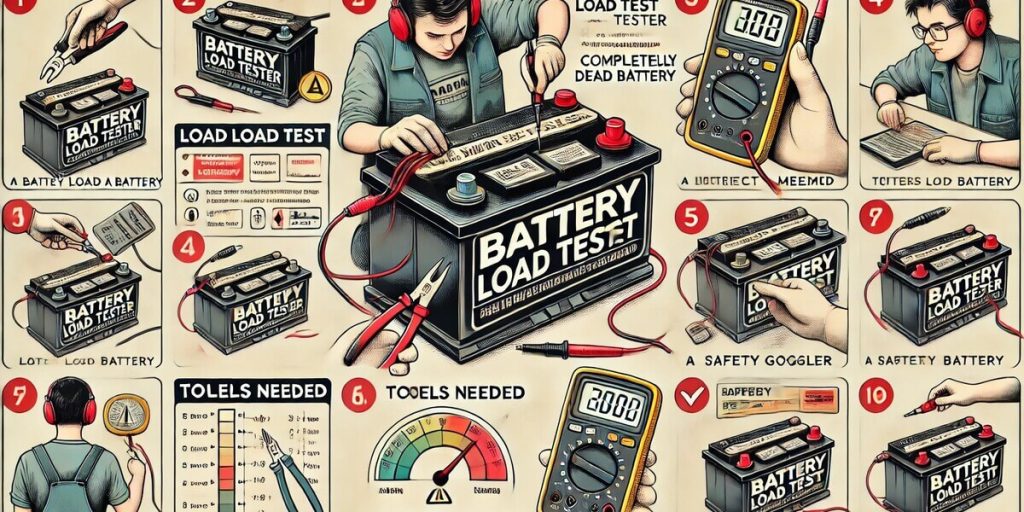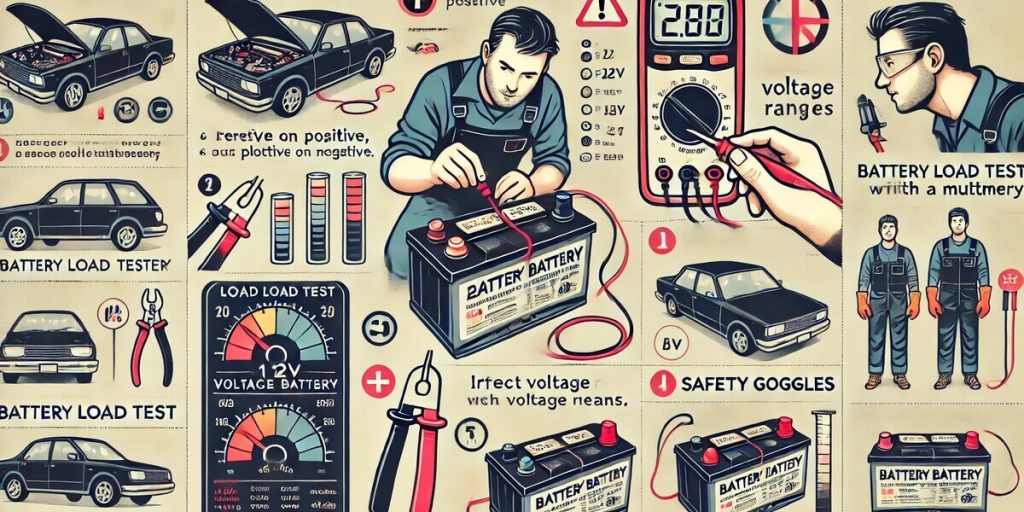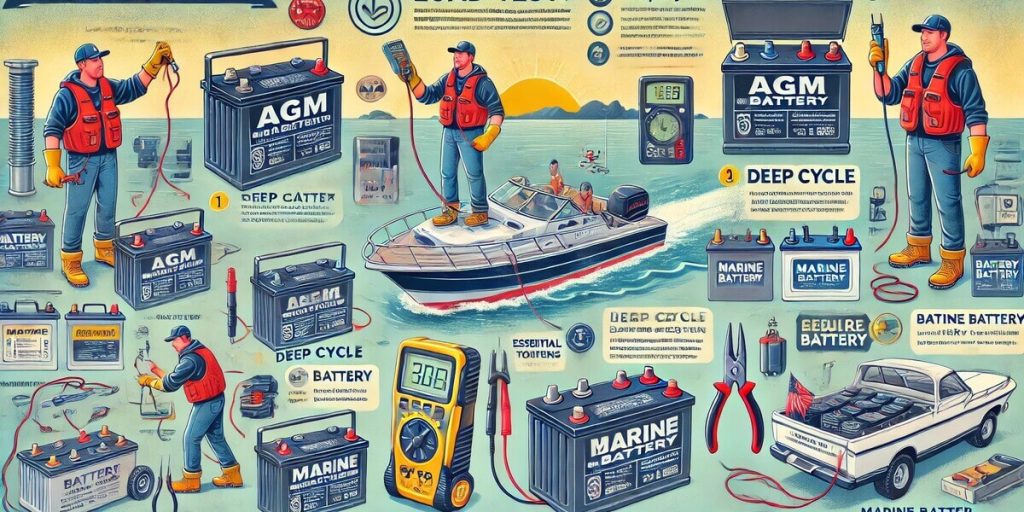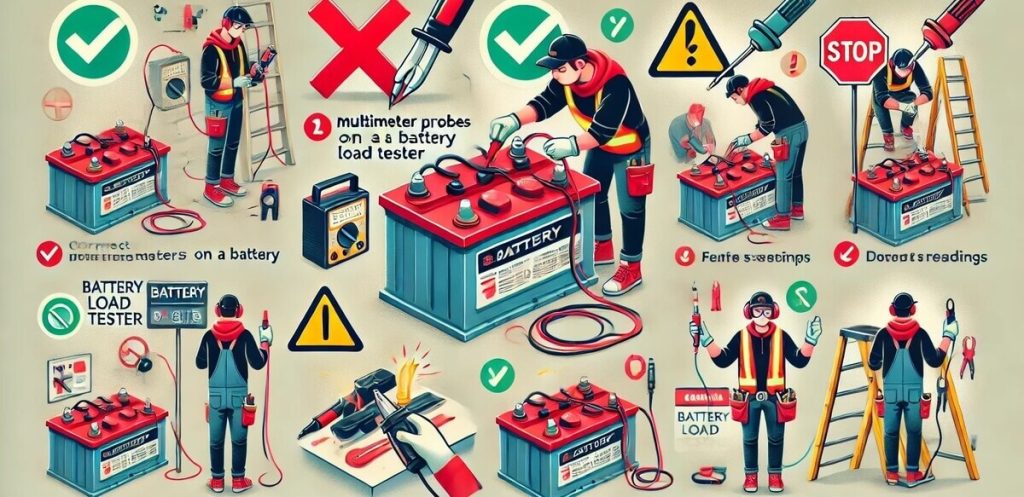Last Updated on February 22, 2025 by Mark S. Taylor
I remember the first time I had to figure out how to load test a battery—my car wouldn’t start, and I wasn’t sure if the battery was weak or completely dead. I had a multimeter but didn’t know what to look for. After some trial and error, I learned a few simple ways to test battery health at home. Whether you use a multimeter, a load tester, or a DIY method, I’ll show you how to check your battery the right way—so you never get stranded.

Contents
Why Load Testing a Battery Matters
I thought my battery was fine—until my car barely started on a cold morning. A voltage test showed 12.6V, which seemed normal. But when I turned the key, the lights dimmed, and the engine struggled. That’s when I learned that voltage testing isn’t enough—you need a battery load test to check if it can handle real power demands.
A weak battery can leave you stranded. If your car has slow starts, dim lights, or weak performance, it’s time for a test. Regular load testing helps prevent breakdowns and keeps your battery in top shape. Let’s look at why it’s so important.
Best Ways to Load Test a Battery
If your car struggles to start, a battery load test can tell you if it’s still good or needs replacing. I’ve tried different methods, from using a load tester to DIY tricks with a multimeter and even a 12V charger. Let’s go over the best ways to check your battery health—with or without special tools.
How to Load Test a Car Battery with a Load Tester
A load tester battery tool puts your battery under stress to see if it holds power.
Step-by-Step Guide:
- Turn off the engine and connect the tester’s clamps to the battery terminals (red to positive, black to negative).
- Apply the load for 10-15 seconds by pressing the tester button.
- Check the voltage drop—a healthy battery stays above 9.6V under load.
How to Interpret Battery Load Test Results
- Above 9.6V = Good battery.
- Below 9.6V = Weak battery, may need charging or replacing.
- Below 9V = Battery is likely dead.

How to Load Test a Battery with a Multimeter
If you don’t have a load tester, a multimeter can still help you check your 12V battery.
How to Load Test a 12V Battery with a Multimeter
- Set the multimeter to DC volts.
- Connect the red lead to positive (+) and black lead to negative (-).
- A fully charged battery should read 12.6V or higher.
- Turn on the headlights for 10-15 seconds, then check voltage again.
Understanding the Readings:
- 12.4V or higher under load = Healthy battery.
- 12.0V – 12.3V = Weak battery, may need charging.
- Below 12.0V = Battery likely needs replacement.
How to Load Test a Battery Without a Load Tester
If you don’t have a tester or multimeter, you can still check battery health with simple DIY tricks.
DIY Methods to Check Battery Health:
- Turn on your headlights for 10 seconds. If they dim quickly, your battery is weak.
- Try starting the car with headlights on. If they flicker or go dark, your battery may not hold a charge.
- Listen for slow cranking. If the engine struggles, the battery may be weak.
How to Load Test a Battery with a 12V Charger
If your battery seems weak, a 12V charger can test if it holds a charge.
Alternative Method Using a Charger:
- Connect the charger to the battery terminals.
- Charge the battery fully and disconnect the charger.
- Wait a few hours, then check the voltage with a multimeter or by turning on the car.
- If the voltage drops quickly, your battery may no longer hold a charge.
A battery load test is the best way to know if your battery is still good. Whether you use a load tester, multimeter, or simple DIY tricks, these methods will help you avoid getting stranded with a dead battery.

Battery Load Testing for Different Types of Batteries
Not all batteries work the same, so load testing them the right way is important. I learned this when I tested an AGM battery like a regular car battery—it gave me the wrong reading! Different batteries need different methods, or you might think a good battery is bad.
For example, AGM batteries need special testing, while deep cycle batteries handle long, steady power instead of short bursts. If you have a marine battery in a boat or RV, knowing how to test it can help you avoid power problems. Let’s go over how to check each type the right way.
Understanding Load Test Results
A battery load test tells you more than just voltage—it shows whether your battery can handle real power demand. The first time I tested mine, I wasn’t sure what the numbers meant. Was my battery weak, or was it time to replace it? Here’s how to read your results.
What a Battery Load Test Chart Shows
A battery load test chart helps compare your battery’s voltage under load. A healthy 12V battery should stay above 9.6V when tested. Anything lower signals weakness.
What Does a Failed Battery Load Test Mean?
If your battery drops below 9V under load, it likely can’t hold a charge. This means it may be too weak to start your car reliably.
When to Replace vs. Recharge a Battery
If the voltage is slightly low, try recharging and retesting. But if the battery fails after charging, it’s time for a replacement. A proper load test can save you from getting stranded!

Common Mistakes and Safety Tips
I’ve made my fair share of mistakes when load testing a battery, from testing a dead battery to not wearing gloves (bad idea!). Testing a battery the wrong way can give false results—or worse, be dangerous. Here’s what you need to know.
Can You Load Test a Dead Battery?
No, a completely discharged battery won’t give an accurate reading. Recharge it first, then test it. If it still fails under load, it’s time for a replacement.
Safety Precautions When Handling Battery Load Testing
- Wear gloves and safety glasses to avoid acid exposure.
- Test in a well-ventilated area—batteries can release gases.
- Never smoke or spark near a battery—it can explode.
- Secure the clamps properly to prevent sparks.
Testing your battery the right way keeps you safe and ensures you get accurate results. Stay careful, and your car will thank you!
FAQs: Load Testing a Battery
Can a battery pass a load test but still be bad?
Yes, a battery can pass a load test but still fail under real use. It may hold voltage briefly but lose power quickly. If your car struggles to start, the battery may be weak.
What voltage should a car battery have after a load test?
A healthy 12V battery should stay above 9.6V under load. If the voltage drops below 9V, the battery is likely weak and may need charging or replacement.
Is a load tester better than a multimeter for battery testing?
Yes, a load tester provides a more accurate result because it measures performance under stress. A multimeter only checks voltage, which doesn’t always show true battery health.
Where can I get a free battery load test near me?
Many auto parts stores like AutoZone and Advance Auto Parts offer free battery load testing. Check with local shops or recycling centers for disposal and testing options.
My Final Thoughts on How to Load Test a Battery
If you want to avoid getting stranded, knowing how to load test a battery is a must. Whether you use a load tester, a multimeter, or a simple DIY method, regular testing helps catch weak batteries before they fail. I’ve learned that a quick test can save time, money, and frustration—and it’s easier than you think.
Take a few minutes to check your battery today. It’s a small step that can keep your car running smoothly and give you peace of mind.
